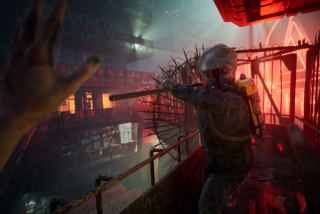Lights! Camera! Joystick!
- Share via
Onscreen, an evil genius feeds a Special Forces agent to a ravenous Bengal tiger. The agent’s beautiful colleague stalks his killer to a Thai jungle, the Korean DMZ and the barren grasslands along the Russian-Mongolian border.
A summer movie spectacular? No. The company that created this scenario actually makes computer games.
It’s all in a day’s work for Larry Shapiro, who produced full-motion video for “Soviet Strike,” a top-selling computer game, and the soon-to-be-released “Nuclear Strike.” Shapiro has also produced MTV videos for the Cranberries, a rock documentary on Brian Wilson and a television special for U2.
“I like to play video games, [and] I absolutely love to make films,” said Shapiro, producer of interactive and new media at Los Angeles-based Palomar Pictures. “This is the best of both worlds.”
It has not escaped Shapiro’s attention that revenues for the interactive entertainment industry may top $5 billion this year and might one day rival box office receipts from film sales.
“My job is to try and bring Hollywood production values to computer games,” said Shapiro. “If players are going to shell out $40 to $60 per game, we have to visually give them their money’s worth.”
Part of what attracted Shapiro to interactive media was his sense that it would also lead to more film work. His goal is to shoot his own video and then hire interactive entertainment companies to create games around his ideas. He hopes to then spin off his computer games into television series and films.
Rod Swanson, director of the “Strike” properties for Electronic Arts, said his San Mateo-based company uses full-motion video to make gamers feel like they are heroes in an action/adventure movie. The trick is to use video footage sparingly, he said. “You also don’t want to distract from the game play.”
Slow motion video with the right look can set a game apart from the competition, said Swanson. The look that Shapiro helped create for “Soviet Strike” stemmed from 10 years spent producing fast-paced music videos for young audiences--a market quite similar to that of computer games.
Onscreen games have come a long way since “Pac Man” and “Pong.” In “Soviet Strike,” a broadcast of a CNN-style foreign correspondent reporting from the Crimea appears at the top of the screen. Below, the grainy black and white likeness of a captive Special Forces agent fades in and out as he sends a plea for help on a Dick Tracy-type wristwatch.
Full motion video helps tell the story, said Swanson, and gives the game a true-to-life feel that can be difficult to capture with computer-generated art.
The computer game business shares another trait with the film industry besides a high level of competition: A handful of expensive blockbusters dominate the field. In 1992, Electronic Arts, a company with annual revenues of more than $600 million, had a staff of three and a $300,000 budget to create “Desert Strike.” Today, Electronic Arts has a staff of 30 and a budget of more than $3.5 million to make “Nuclear Strike.” The San Mateo-based company has already sold some 3-million units of its “Strike” computer games.
Shapiro is quick to point out that adding full-motion video to computer games has more often led to failure than success.
“The problem is too many game designers and game creators want to be directors so they try and turn their games into films,” Shapiro said. “We are filmmakers but we love games and we want to use our cinematic production values and enhance the game.”
*
Gali Kronenberg is a freelance writer based in Los Angeles. He can be reached at gali.kronenberg@latimes.com
(BEGIN TEXT OF INFOBOX / INFOGRAPHIC)
Bio Box
Name: Larry Shapiro
Job: Producer of interactive and new media
Employer: Palomar Pictures, Los Angeles
Age: 32
Education: Bachelor’s degree in film and television, New York University
Home: Sherman Oaks






